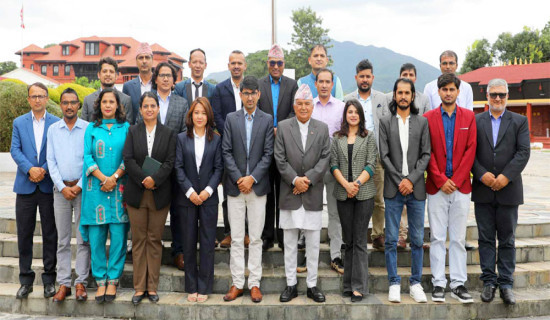- Wednesday, 16 July 2025
Cultural Faiths, Medical Science Intersect
According to the lunar Hindu calendar, the month of Shrawan, which falls in July and August on the Roman calendar, commences with Saune Sankranti. In Nepal, this day is also called luto falne din, or the day to rid oneself of scabies. Religious scholars explain that during Shrawan, the sun aligns with the zodiac sign Cancer, intensifying both heat and rainfall. These conditions often become extreme, especially as people spend more time outdoors for rice planting, particularly in the Kathmandu Valley. Farmers and labourers are frequently drenched, exposed to insects, mud, and contaminated water. This combination of heat, humidity, and unsanitary conditions can lead to a surge in skin-related health issues, including rashes, herpes, scabies, and sores.
As the rainy season begins, heavy downpours often wreak havoc through floods and landslides, washing away infrastructure, livelihoods, livestock, and even lives. This year, the Ministry of Health has issued an alert noting an upsurge of skin problems in the Kathmandu Valley. Science, religion, culture, and tradition frequently overlap in unexpected ways, offering insights into how communities have adapted to seasonal realities over generations.
Herbal applications
Traditionally, Saune Sankranti is considered a day for cleansing and curing such ailments. Families follow rituals to wash away scabies, reflecting an intersection of cultural beliefs and practical health awareness. Today, this connection is echoed in hospitals reporting increased cases of skin diseases during this season. Modern medicine addresses these problems through dermatological treatments, while traditional practices such as Ayurvedic remedies, mud therapy, and herbal applications are also commonly used.
Shrawan is further significant as the month dedicated to Lord Shiva, who occupies a revered place in the hearts of most Nepalis, regardless of their caste, ethnicity, religion or regional identity. The Pashupatinath Temple and the mythical Kailash Parbat — both associated with Shiva — are among the holiest sites for Hindus worldwide. Pilgrims dream of visiting Nepal at least once in their lifetime to perform darshan at these sacred sites. Within Nepal itself, communities are so interwoven that Shiva’s symbolism resonates far beyond religious boundaries.
Shiva, one of the Hindu Trinity — Brahma, Vishnu, and Maheshwor — is linked with both creation and destruction. He is also seen as a symbol of love and romance. The unity of yoni and linga represents the powerful love and tragedy shared by Shiva and Parvati. For me, the most compelling message from Lord Shiva is the call to love and protect nature. His entire presence is entwined with natural elements: the Ganga flowing from his hair, the serpent coiled around his neck, and a lion skin covering his body.
In the famous Hindu epic Samudra Manthan—the churning of the ocean—when deadly poison emerged, Shiva drank it to save humanity. Numerous stories in the Shiva Purana recount how he protected the Himalayas, rivers, forests, animals, and people from destruction. At the same time, he used his third eye to eradicate evil forces threatening the balance of the world. The month of Shrawan, with its abundant rains, underscores Shiva’s connection with water and renewal. It is believed that during this period, Shiva, also known as Shambhu, walked from Kailash Parbat to the North Pole, symbolically traversing the world. This month also begins a series of festivals in Nepal, including Janai Purnima (Raksha Bandhan), Nag Panchami, and Haritalika Teej.
Women especially fast every Monday throughout Shrawan, praying to Lord Shiva for a husband like him. The romantic ideal of Shiva and Parvati has woven itself into the Hindu community’s collective aspirations. Shrawan Mondays and Haritalika Teej have become occasions where women undertake rigorous fasts, believing this will help them secure a loving marriage and prolong their husbands’ lives. However, traditions and cultures are human constructs that need reflection and adaptation over time. Unfortunately, many interpretations were historically dictated by religious leaders — mostly men from dominant communities—and now by market-driven forces. The emphasis on securing a “good husband” and accepting a woman’s subordination to her spouse became ingrained in patriarchal mindsets.
Instead of embracing Shiva’s deeper values — protecting nature, standing up against injustice, and recognising Parvati’s strength as a force who defeated demons — our society continues to reinforce rituals that demand women fast without a drop of water and believe marriage is the ultimate purpose of their existence. Compounding this mindset is the relentless marketing of red, green, and yellow clothing, jewellery, and bangles, presented as essential symbols of devotion and prosperity.
Commercialisation of festivals
The commercialisation of these festivals has shifted their focus. The day before Haritalika Teej, traditionally known as dar khane din — a day when daughters and daughters-in-law were welcomed by their mothers and mothers-in-law for a communal feast — has transformed. Today, lavish parties are organised in hotels weeks in advance, while gatherings at family homes are slowly disappearing. What was once an intimate celebration has increasingly become a show of social status and consumerism.
This year, let us honour the values embedded in our traditions: staying vigilant about seasonal health risks, such as skin diseases, and working to preserve the natural world — our water, animals, and vegetation. The younger generation, in particular, has a responsibility to question wasteful spending and oppressive practices. Modernity is not about spending blindly. It is about cultivating habits that protect our environment and embracing cultural practices that uplift rather than constrain. As we look toward the future, let us reimagine Shrawan as a month of renewal—of our connection to nature, our respect for human dignity, and our collective effort toward climate and resource conservation.
(Sharma is a senior journalist and women’s rights advocate. namrata1964@yahoo.com or on X @NamrataSharmaP.)

















